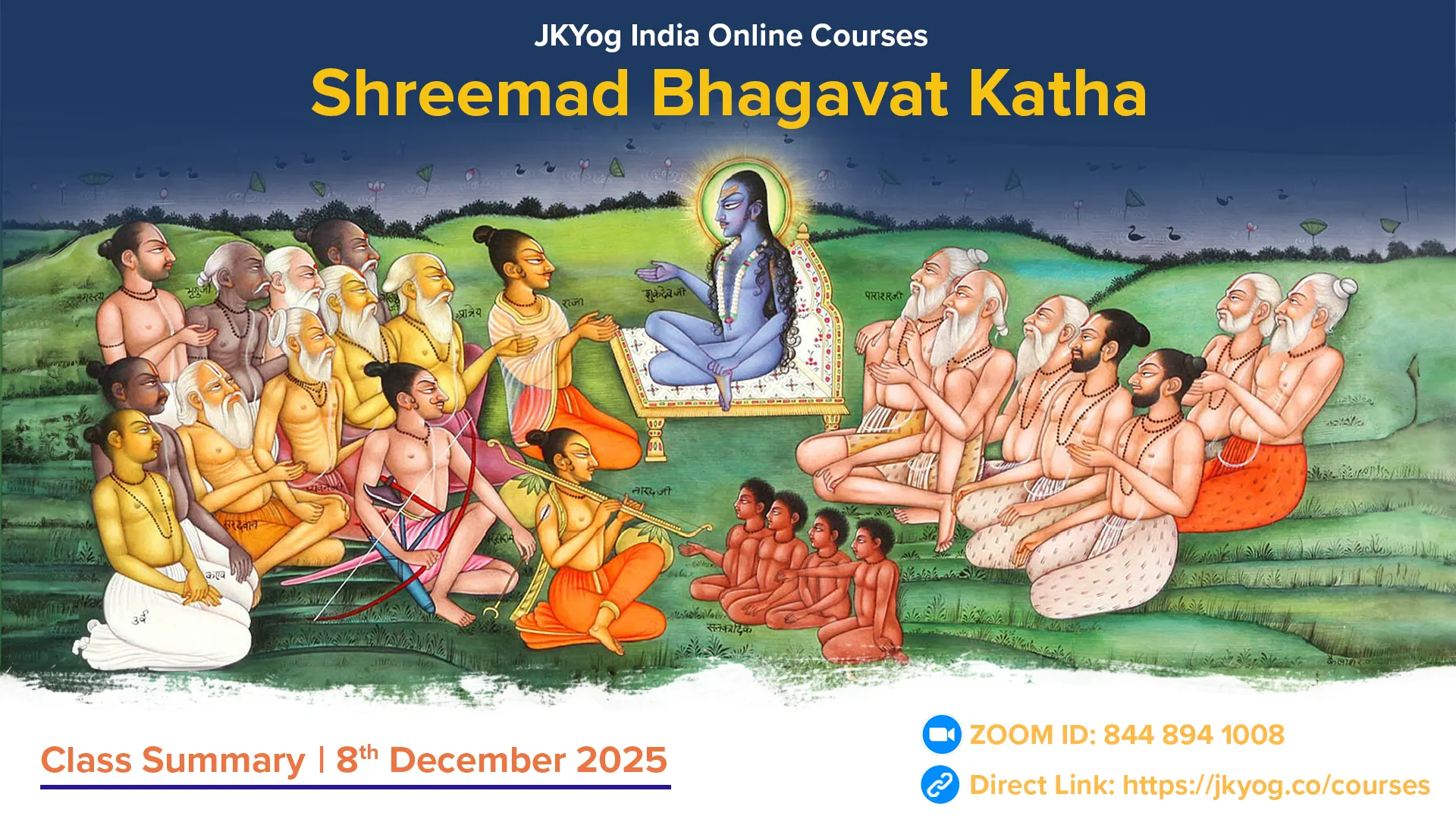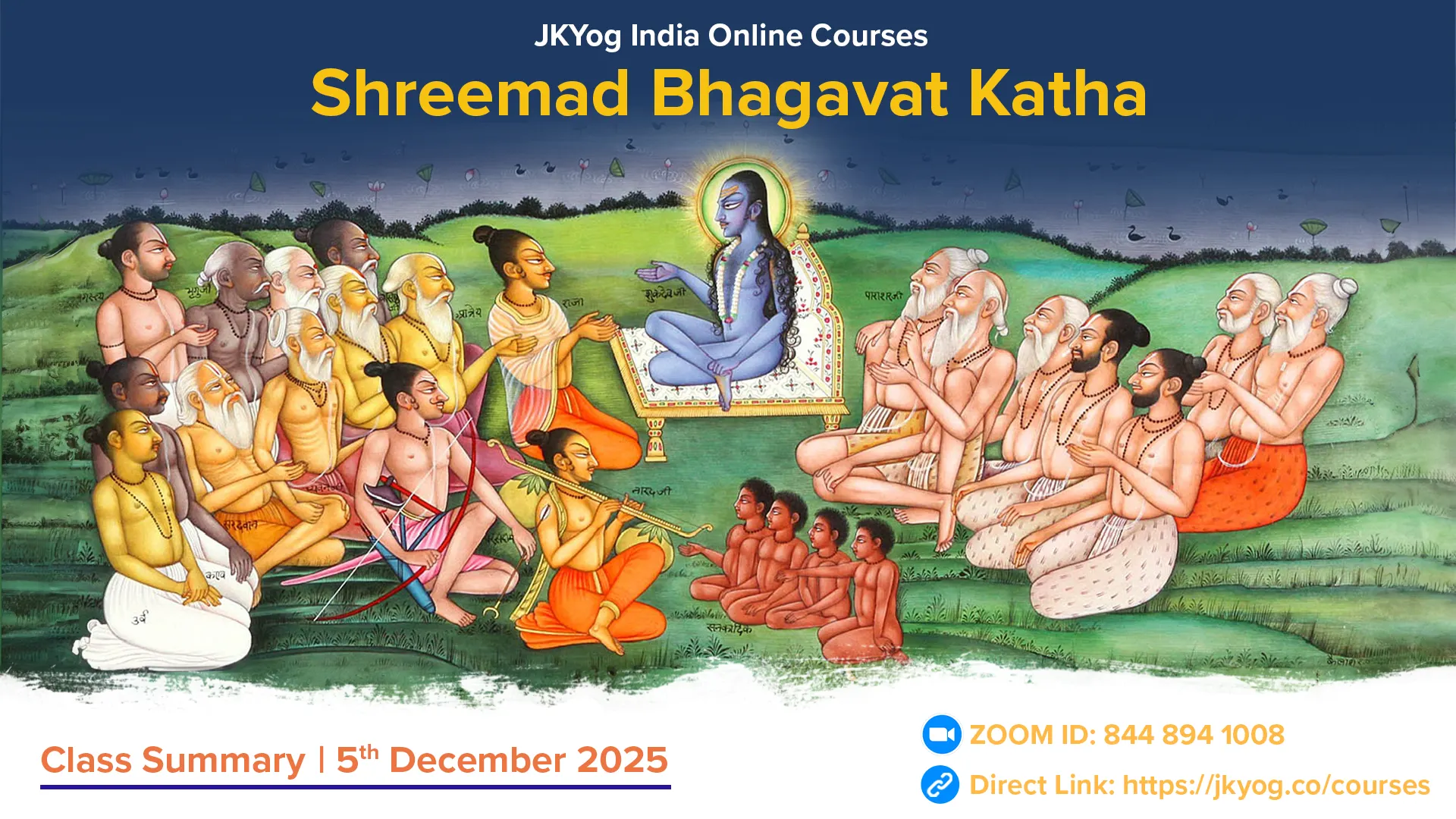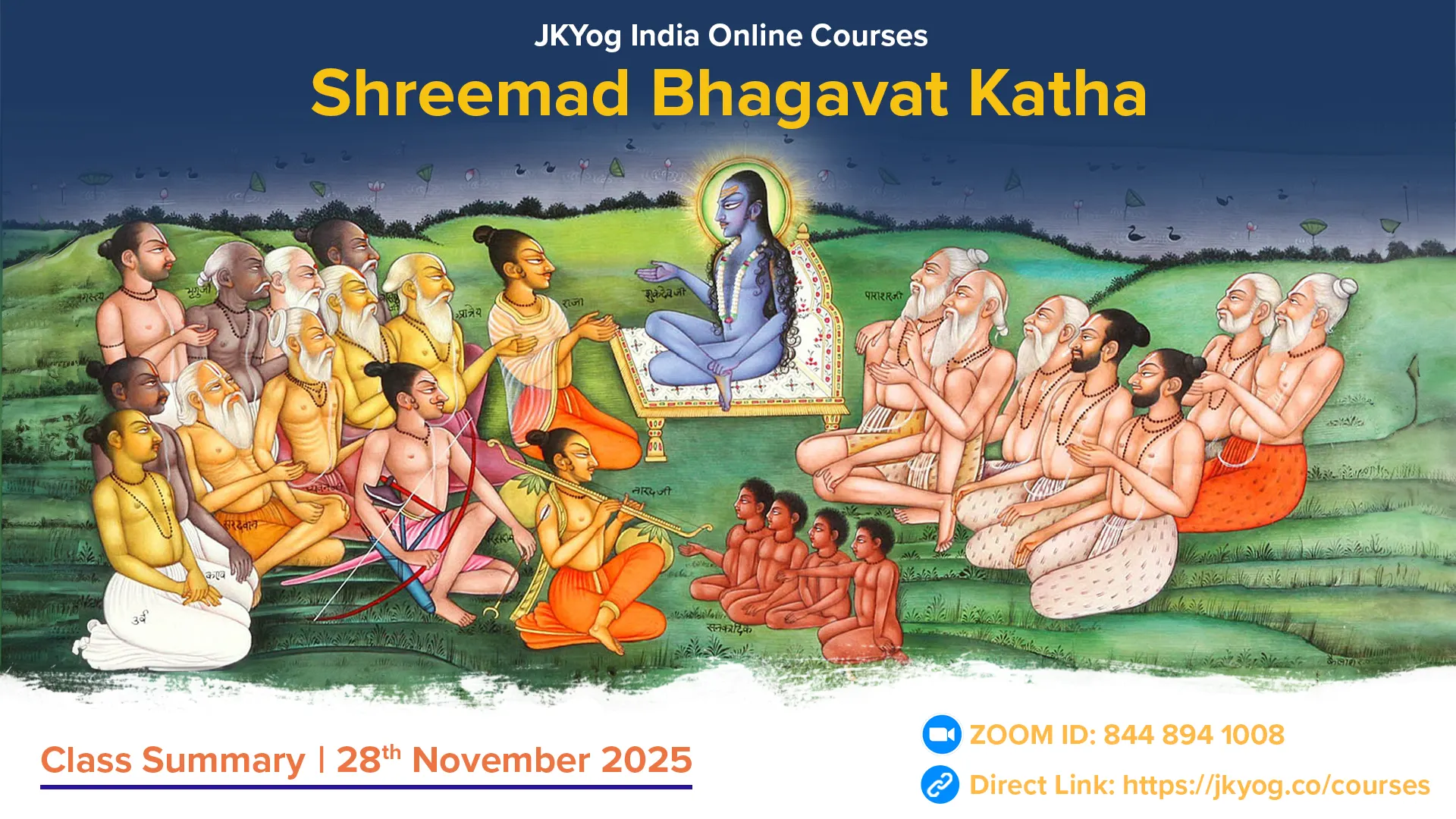After the story of Gokarna, the Sanakadi Rishi explains to Naradji the method of listening to the Bhagavat Saptah. Then, the Rishis narrate the Bhagavat Katha. At the end of the narration, Narad says, "I am blessed. You have graciously blessed me immensely. Today, I have attained the Bhagwan Shree Hari, who destroys all sins. I consider listening to the Shreemad Bhagavatam the supreme of all rituals because by listening to it, one attains Shree Krishna, the Lord of Goloka."
Sutaji tells Shaunakjii that Vyas's son Shukadevaji arrived at that time. Who is always 16 years of age, he is slowly and lovingly reciting the Shreemad Bhagavatam. Seeing the highly radiant Shukadevaji, all the assembly members immediately stood up and seated him on a high seat. Then, Naradji worships him. Sitting comfortably, he says the great sage Vyas had composed the Shreemad Bhagavat Mahapuran. It elucidates the supreme dharma free from deceit and desire. It describes the beneficial reality that pure-hearted people need to know, which liberates souls from three kinds of suffering. Once one takes refuge in it, there is no need for other scriptures or means.
When virtuous souls wish to listen to it, God promptly comes into their hearts. This Bhagavat is the crown jewel of the Puranas and the wealth of the Vaishnavas. It describes the pure knowledge attained by the Paramahamsas and highlights the path of renunciation, wisdom, detachment, and devotion. The person who diligently listens to, reads, and contemplates it with devotion attains liberation. This nectar is not available even in the celestial worlds, Satyaloka, Kailash, or Vaikuntha. Therefore, one should drink it abundantly and never leave it. The Bhagavat Katha has the power to transform and inspire us on our spiritual journey.
As Shukadevaji speaks, Shree Krishna appears, accompanied by Prahlad, Bali, Uddhav, Arjun, and other parshads. Naradaji seats Him on a throne, and everyone begins singing in His presence. Soon, Shiva arrives with Parvati and Brahma. Prahlad starts playing the cymbals, Uddhav picks up the jhanjh, Naradaji strums the veena, Arjun sings, Indra plays the mridangam, and Shukadevaji expresses profound emotions with gestures, dancing as Bhakti, Gyan, and Vairagya come alive in a mesmerising performance.
Shree Krishna, delighted by this display, invites them to ask for a boon. In unison, they request that wherever the Bhagavat Katha is told in the future, He should always come with His parshads. Shree Krishna responds with "Tathastu" (so be it) and vanishes. Naradaji then bows to Shukadevaji and the others. Shukadevaji firmly establishes Bhakti, Gyan and Vairagya in the Bhagavat, and everyone returns to their respective places.
Shaunakaji then asks Sutaji when Shukadevaji narrated this story to Parikshit, Naradaji, and the Sanakadi Rishis. Sutaji explains that after Shree Krishna departed to His abode and thirty years of Kaliyug had passed, Shukadevaji narrated the Shreemad Bhagavat Katha to Parikshit on the Shukla Navami of the month of Bhadrapada. After King Parikshit's liberation, two hundred years of Kaliyug passed, and then on the Shukla Navami of the month of Ashadha, Gokarna narrated the Shreemad Bhagavat Katha. After another thirty years of Kaliyug, the Sanakadi Rishis started narrating the story from Kartik Shukla Navami to Naradaji.
Sutaji then emphasises that everyone should listen to this Shreemad Bhagavat Katha. For your well-being, drink even a drop of this incomparable nectar of Shuka-Shashtra (Bhagavatam), even for half a moment. Why wander in worthless, sinful stories? As soon as this divine story enters the ears, one attains liberation, as testified by King Parikshit. Shree Shukadevaji narrated this story while immersed in the flow of love. "Shaunakaji, having referred to many scriptures, have now narrated this supreme secret to you. This is the essence of all the principles of the scriptures. There is nothing more sacred in the world than this Shuka-Shashtra (Bhagavatam)," says Sutji.
This concludes the Shreemad Bhagavat Mahatmya and the main scripture begins with a Mangalacharan (invocation).
Janmaadyasya yato'nvayaa-ditara-shchaar-thesvabhiijnah swaraat।
Tene brahma hridaa ya aadi-kavaye muhyanti yat-suurayah।।
Tejo-vaarimrdaam yathaa vinimayo yatra trisargo'mrshaa।
Dhaamnaa swena sadaa nirasta-kuhakam satyam param dheemahi।।
I meditate on the Supreme Truth and the root cause of the creation, sustenance and destruction of all manifested universes. He is fully aware of all manifestations, directly and indirectly, and is separate from unreal substances; He is not inert but conscious; He is not dependent but self-illuminating; He is not Brahma or Hiranyagarbha, but He who by His own will bestowed the knowledge of the Vedas; about which even the greatest scholars are bewildered; just as we are bewildered by illusion– water in the desert or land shimmering on a lake. Similarly, this threefold creation, a product of the three modes of nature, appears real only because of Him. Though false, it seems to be true in the form of waking-dream-sleep. Therefore, I meditate on Him, the Supreme Truth, who eternally exists in the divine realm, untouched by the illusory manifestations of the material world. I meditate on Him because He is the Supreme Truth. (Bhagavat 1-1-1)
Dharmah projjhita-kaitavo'tra paramo nirmatsaranam satam
Vedyam vastavamatra vastu shivadam tapa-trayon-mulanam
Shrimad-bhagavate mahamuni-krite kim va parairee-shvarah
Sadyo hridayavaru-dhyate'tra kritibhih shushru-shubhist-atksha-nat
The Shreemad Bhagavatam, authored by the great sage Vyas, expounds the ultimate dharma devoid of any fruitive results up to liberation. It elucidates the supreme truth of God, knowable only to those seeking pure knowledge, which destroys the root cause of all three types of suffering and bestows ultimate welfare. What more needs to be achieved through any other means or scriptures? Whenever a person of good fortune desires to hear it, the Supreme God promptly manifests in their heart and becomes their guide. (Bhagavat 1-1-2)
Nigama-kalpa-taror-galitam phalam
shuka-mukhaa-damrita-drava-samyutam
Pibat bhagavatam rasamalayam
muhuraho rasika bhuvi bhaavukaah
Dear connoisseurs of divine essence! This Shreemad Bhagavatam is the ripe fruit of the Vedic wish-fulfilling tree. It has become enriched with the nectar of supreme bliss upon being associated with the divine discourse from the mouth of Shukadeva. There is no part like peel or seeds to discard in this fruit; it is pure essence. This is the embodiment of sublime taste. As long as there is consciousness in the body, continuously consume this divine nectar of Bhagavad rasa. It is readily available on this Earth. (Bhagavat 1-1-3)
Shree Krishna is the Essence of Vedas
In the Naimisharanya forest, Shounakji asks Sutaji to narrate the essence of all the Vedas and Upanishads for the welfare of lazy souls with short lifespans in the Kaliyug. Then, Sutaji respectfully greets Shukadevji and begins narrating the divine Bhagavat Katha.
Sa vai pumsam paro dharmo yato bhaktir adhokshaje
Ahaituky apratihata yayatma samprasidati
The supreme dharma (duty) for humans is that which fosters devotion to Bhagwan Shree Krishna—devotion that is free from all desires and continuous and ultimately leads to the attainment of the blissful form of the Supreme Soul, making one feel fulfilled. (Bhagavat 1-2-6)
The essence of the Vedas is enshrined in Shree Krishna alone. The primary objective of Yagya also revolves around Shree Krishna. The practice of yog is pursued for Shree Krishna alone, and all actions culminate in Him. Through the medium of knowledge, one attains the realisation of Shree Krishna, the embodiment of Brahman. Austerity is also undertaken for Shree Krishna's satisfaction. The observance of dharma is dedicated solely to Shree Krishna, and all paths merge into Him. Bhagawan creates various yonis (species), inhabits them and experiences the world from their perspectives. He creates and sustains the world, taking on different forms, such as gods, animals, birds, and humans, to nurture all living beings through the quality of purity and goodness known as the Sattva Guna.
The story of Bhagawan's avatars
Bhagawan expanded Himself as Mahavishnu upon desiring creation, also known as Karanodakshayi Vishnu. He is considered the first Purusha and resides in the divine waters of the causal ocean. Mahavishnu manifests countless physical universes through the pores of His body. Then, He resides in the pit of each universe as Garbhodakshayi Vishnu, also called the second Purusha. From Garbhodakshayi Vishnu's navel, Brahma is born, who guides the process of creation. He creates various elements, laws of nature, cosmic rivers, and planetary systems.
Garbhodakshayi Vishnu expands Himself further as Kshirodakshayi Vishnu and resides atop every universe. Kshirodakshayi Vishnu is known as the third Purusha. He also resides within the hearts of all beings in the form of Paramatma (Paramātman/परमात्मन्) and keeps a record of their actions.
Yogis see this form of God with divine vision. It has thousands of legs, thighs, arms, faces, and thousands of heads, ears, eyes, and nostrils. He is adorned with thousands of crowns, clothes, and ornaments. This form of God, known as Narayana, is the inexhaustible treasure of countless avatars.
Principle Avatars of Bhagwan
- Sanak, Sanandan, Sanatan, Sanatkumar Avatars: Manifested as four Brahmins practising austere celibacy.
- Sukar Avatar: Assumed the form of a boar to lift the Earth from Rasatala.
- Narad Avatar: Incarnated as the sage Narad to impart teachings of Narad-Pancharatra.
- Nar-Narayan Avatar: Practiced severe austerities by controlling the mind and senses.
- Kapil Avatar: Dispensed teachings of Sankhya philosophy.
- Dattatreya Avatar: Manifested as the son of Atri and Anasuya.
- Yajna Avatar: Incarnated as Yajna to protect the Svayambhuva Manvantara.
- Rishabhadev Avatar: Manifested while following the path of Paramahamsa.
- Prithu Avatar: Drew out medicinal herbs from the Earth.
- Matsya Avatar: Assumed the form of a fish to protect the Earth.
- Kachhap Avatar: Supported Mount Mandara on His back during the churning of the ocean.
- Dhanvantari Avatar: Emerged from the ocean with the nectar (Amrit).
- Mohini Avatar: Deluded the demons and made the gods drink the nectar.
- Narasimha Avatar: Slew Hiranyakashipu.
- Vamana Avatar: Requested three paces of land from demon king Bali.
- Parashurama Avatar: Liberated the Earth from the Kshatriyas twenty-one times.
- Vyas Avatar: Divided the Vedas into several branches.
- Ram Avatar: Engaged in the slaying of Ravan and building the bridge to Lanka.
- Balaram and Shree Krishna Avatars: Appeared in the Yadu dynasty, lifting the burden of the Earth.
- Buddha Avatar: Manifested at the beginning of Kaliyug.
- Kalki Avatar: Will appear at the end of Kaliyug to destroy unrighteousness.
Summary: JKYog India Online Class- Shreemad Bhagavat Katha [Hindi]- 24.06.2024








